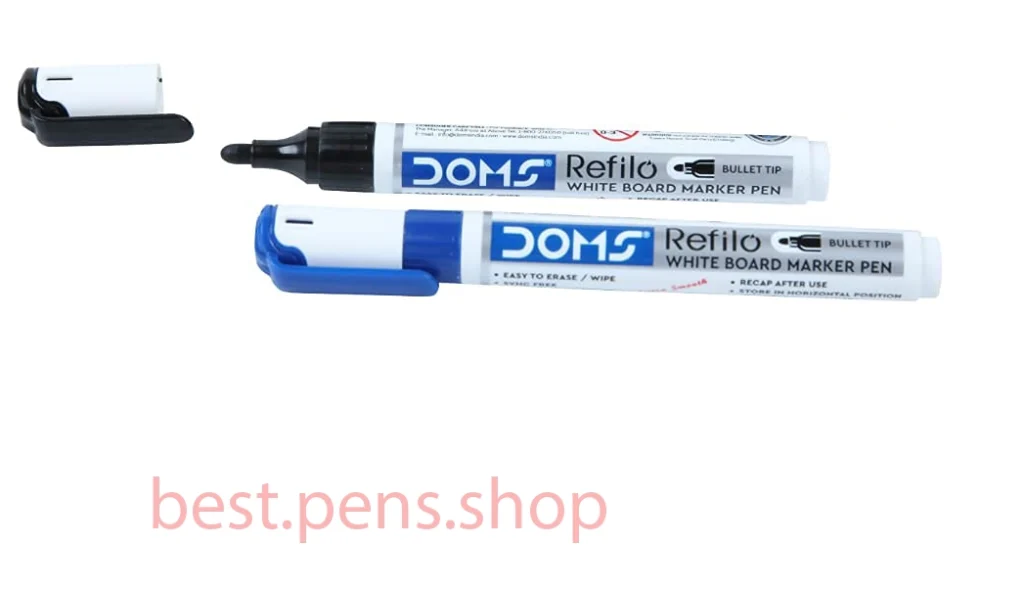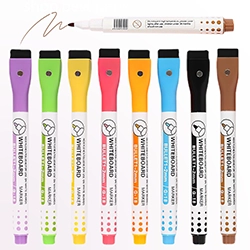Temporary Markers and Whiteboards: A Comprehensive Guide
Temporary markers and whiteboards are practical tools used in various professional, educational, and personal settings. Their combined usage provides an eco-friendly, reusable, and flexible approach to note-taking, presentations, brainstorming, and more. This guide explores the features, uses, and advantages of these Best temporary marker pen for whiteboard.

Best pick – 1
Key Features of Temporary Markers
| Feature | Description | Example |
|---|---|---|
| Erasable Ink | Easily wiped off with a dry or damp cloth; ideal for non-permanent markings. | Writing meeting agendas on whiteboards. |
| Non-Permanent | Leaves no stains or marks on compatible surfaces when erased correctly. | Temporary designs on glass or laminated sheets. |
| Surface Compatibility | Works on non-porous surfaces like whiteboards, mirrors, glass, and ceramics. | Writing reminders on a fridge or glass notice boards. |
| Variety of Colors | Available in vibrant shades for visibility and creative applications. | Highlighting key points during brainstorming sessions. |
| Eco-Friendly | Promotes reuse by reducing reliance on disposable paper notes. | Using laminated calendars with erasable markers. |
Primary Uses of Temporary Markers and Whiteboards
1. Educational Applications
Temporary markers and whiteboards are extensively used in classrooms and training sessions to simplify concepts.
- Problem Solving: Students are encouraged to solve mathematical problems interactively.
- Visualization: Complex ideas, such as diagrams or flowcharts, are illustrated with ease.
- Interactive Participation: Students can write their answers or share ideas directly on the board.
| Example | Benefit |
|---|---|
| Drawing biological diagrams | Enhanced understanding of anatomy or processes. |
| Writing vocabulary words | Improves retention through visual learning. |

Best pick – 2
2. Business and Office Use
In professional settings, temporary markers and whiteboards aid in organizing, presenting, and planning.
- Brainstorming Sessions: Teams can share and visualize ideas collaboratively.
- Task Tracking: Kanban boards or timelines are created for managing deadlines.
- Presentations: Data and strategies are visually presented during meetings.
| Task | Whiteboard Functionality |
|---|---|
| Project management | Listing tasks, assigning deadlines, and tracking progress. |
| Strategy sessions | Visualizing SWOT analysis or competitive frameworks. |
3. Creative Expression
Whiteboards provide a canvas for temporary sketches and drafts.
- Design Drafting: Architects and designers use whiteboards for quick layouts.
- Storyboarding: Filmmakers and writers draft scenes visually.
- Artistic Planning: Temporary drawings or pattern ideas are explored.
| Example | Outcome |
|---|---|
| Sketching a building design | Facilitates adjustments before finalizing. |
| Drafting a comic strip | Allows iterations before inking. |
4. Household Applications

Best pick – 3
Temporary markers and whiteboards simplify daily tasks and communication at home.
- Family Schedules: A family calendar can be maintained on a whiteboard.
- To-Do Lists: Shopping or chore lists are easily updated.
- Homework Assistance: Children can practice math or spelling on whiteboards.
| Activity | Example |
|---|---|
| Writing daily reminders | “Doctor’s appointment at 4 PM.” |
| Tracking chores | Assigning “dishwashing” or “vacuuming” to family members. |
5. Personal Productivity
Whiteboards help individuals streamline goals and tasks.
- Goal Visualization: Personal targets can be written and tracked.
- Habit Monitoring: Checklists for habits, like exercise, are easily maintained.
- Inspiration Boards: Motivational quotes or ideas can be displayed.
| Use Case | Benefit |
|---|---|
| Writing daily priorities | Keeps focus sharp on immediate tasks. |
| Visualizing long-term objectives | Reinforces commitment to goals. |
6. Collaborative Work

Best pick
Whiteboards promote teamwork by serving as a collaborative tool.
- Group Discussions: Ideas can be shared and refined in real-time.
- Workflows: Process maps or team structures are visualized for clarity.
- Workshops: Participants engage by contributing directly to the board.
| Scenario | Outcome |
|---|---|
| Brainstorming a marketing campaign | Generates diverse ideas quickly. |
| Mapping a production process | Identifies inefficiencies and areas for improvement. |
7. Temporary Note-Taking
Temporary markers are ideal for jotting down quick notes.
- Announcements: Important messages can be temporarily displayed.
- Phone Numbers: Easily noted and erased after use.
- Event Plans: Short-term planning can be visualized.
| Example | Ease of Use |
|---|---|
| Writing a Wi-Fi password | Can be erased when no longer needed. |
| Drafting quick reminders | Eliminates the need for sticky notes. |
8. Training and Workshops
Temporary markers and whiteboards enhance interactive learning during sessions.
- Techniques Demonstration: Trainers use whiteboards to show methods step-by-step.
- Key Points: Important notes are highlighted for trainees.
- Q&A Sessions: Participants write questions or answers directly.
| Scenario | Impact |
|---|---|
| Training new hires | Visual aids improve comprehension of company policies. |
| Workshop on problem-solving | Engages participants actively. |
Comparison: Temporary Markers vs. Other Tools
| Feature | Temporary Markers | Permanent Markers | Digital Tools |
|---|---|---|---|
| Reusability | Can be erased and reused | Not reusable; markings are permanent. | Reusable, but dependent on power and software. |
| Eco-Friendliness | High; reduces paper use. | Low; not sustainable. | Medium; energy-intensive. |
| Ease of Use | Simple; no technical skills needed. | Simple; requires no maintenance. | Requires setup and knowledge of tools. |
Conclusion
Best temporary marker pen for whiteboard remain indispensable for education, business, creativity, and personal productivity. Their flexibility, ease of use, and environmental benefits make them invaluable for tasks requiring temporary visual expression. Whether brainstorming, teaching, or managing personal goals, these tools provide a reliable and sustainable solution.